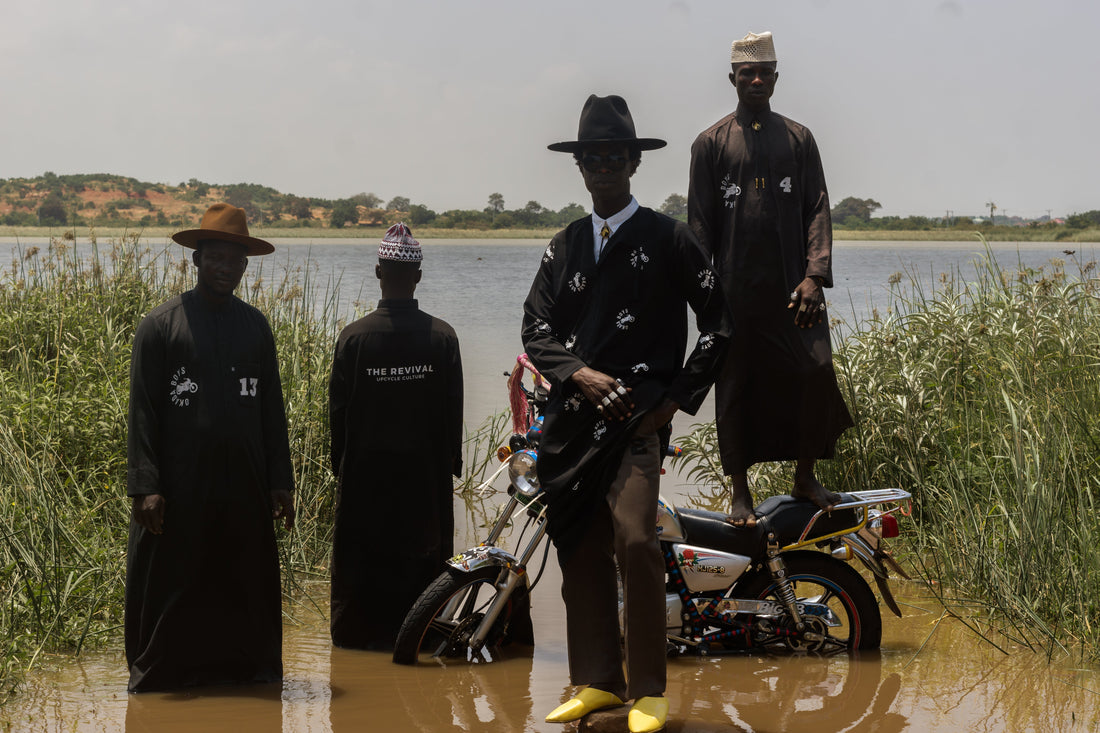
Yayra Agbofah & The Revival: Circular fashion rising from Kantamanto
Share
Yayra Agbofah is the founder of The Revival, a circular fashion studio transforming Ghana’s textile-waste crisis into opportunity.
Growing up near Kantamanto, the world’s largest secondhand market, he witnessed the environmental and economic toll of discarded garments and chose to act. Through upcycling, community training, and design innovation, Yayra gives new life to millions of used clothes while creating jobs and reducing emissions.
Winner of the 2025 Global Change Award, he champions Africa’s leadership in circular fashion, proving that waste can become a resource and a source of dignity.

The Revival was born out of the huge textile waste challenge in Ghana — how did you decide to respond to it through circular fashion?
I grew up around the Kantamanto market, one of the world’s largest secondhand clothing markets, and witnessed firsthand the consistent decline in quality of used clothing causing losses to traders and polluting our environment. Every week, millions of used garments arrive in Accra, and about 20-30% end up as waste. Instead of only seeing waste, I saw untapped potential. Founding The Revival was my way of responding creatively and practically transforming discarded textiles into valuable resources through upcycling, innovation, and community-driven solutions. Circular fashion allows us to give these clothes new life while restoring dignity to the people who handle them.

Are there particularly powerful moments or stories from individuals in Kantamanto or beyond that stay with you?
One story that always stays with me is of a young kayayei (female head porter) who carries bales of used clothing on her head every day. She told me she dreams of becoming a designer, but her reality is carrying waste. Through The Revival, she now participates in our incubator program where she learns sewing and design skills. Her smile the first time she made her own garment reminded me why this work matters. It’s about shifting lives, not just clothes.
As a winner of the 2025 Global Change Award, how does this recognition affect The Revival’s ability to scale its circularity model?
Winning the Global Change Award was a huge milestone. Beyond the financial support, it has given The Revival credibility and visibility on a global stage. It has opened doors to new partnerships, mentorship, and investment opportunities, which are critical to scaling our Circularity Lab and community training programs. Most importantly, it has amplified our message that Africa is not just receiving waste but is leading in innovation for the circular economy.

Could you elaborate on how The Revival’s Circularity Lab transforms textile waste – what are the steps from discarded second‑hand garments to upcycled creations?
The Circularity Lab is our experimental hub where discarded textiles are given new value. The process usually starts with sorting and identifying materials with upcycling potential. Then we clean, deconstruct, and redesign the textiles — sometimes combining multiple garments into one new creation. We also explore recycling techniques like shredding textiles into fibers for paper, bricks and design materials. Each stage is collaborative, involving market traders, tailors, and young creatives, making it a community-led process.

How do educational initiatives and community outreach shape public perception and participation in circular fashion?
Education is central to what we do. Many people see Kantamanto as just a chaotic market, but through tours, workshops, online courses and exhibitions we show the creativity, resilience, and global significance of the community. Our outreach programs also empower young people with skills in upcycling, storytelling, and entrepreneurship, helping shift the narrative from waste colonialism to resourcefulness. Changing perceptions is the first step to changing systems.

The motto of ILANGA is Modifying Perspective. What does Modifying perspectives mean to you?
To me, modifying perspectives means challenging the single story. Kantamanto has long been seen as a dumping ground, but in reality it is a hub of innovation, labor, and circularity. By modifying perspectives, we help people see waste as a resource, traders as entrepreneurs, and communities as leaders in global sustainability.
At ILANGA, we focus on transforming food waste — like onion skins or avocado peels — into natural dyes for textile industry. When you think about color, what does it mean to you beyond aesthetics?
Color carries memory, culture, and identity. In Ghana, every shade tells a story, from the deep indigo of traditional dyeing to the bold patterns of kente. Beyond aesthetics, color connects us to heritage, nature, and emotion. For me, it’s also about transparency: knowing where a color comes from, how it’s made, and the impact it leaves behind.

Could you describe your approach to natural dyeing? What materials, techniques, or local traditions do you draw upon?
We use natural dyeing both in our studio and through collaborations with the indigo dyers in the Northern part of Ghana which has been a tradition passed on from generation to generation. It’s both an environmental and cultural practice, reducing chemical pollution while keeping indigenous knowledge alive.

How does natural dyeing influence the textures, colors, and stories of the garments you create?
Natural dyes give garments a unique character. No two pieces are ever identical, each carries subtle variations in tone and texture that make it one-of-a-kind. The colors also age beautifully over time, much like the stories of the people who wear them. This imperfection is what makes the pieces human, alive, and connected to nature.
How can global audiences, institutions, or governments support and amplify community‑based circular fashion models like yours?
Global audiences can support by rethinking their consumption habits and choosing circular, ethical alternatives. Institutions can invest in infrastructure and innovation for textile recycling, while governments must create policies that hold fashion brands accountable for the waste they export. Most importantly, support should empower local communities — not replace them — ensuring those at the frontlines of the crisis are also leading the solutions.
What advice would you share with creative-minded people or communities wanting to start local circular fashion initiatives but who lack resources or networks?
Start small with what you have. Creativity thrives in constraint. Use your local resources, whether that’s discarded textiles, natural dyes, or traditional skills. Build community, collaboration is more powerful than competition. And don’t wait for permission from big institutions; grassroots solutions are often the most innovative. Share your story boldly, because storytelling attracts networks, resources, and allies who will help your initiative grow.
Follow The Revival on Instagram
Connect with Yayra on LinkedIn
Read more about The Revival on their website.
